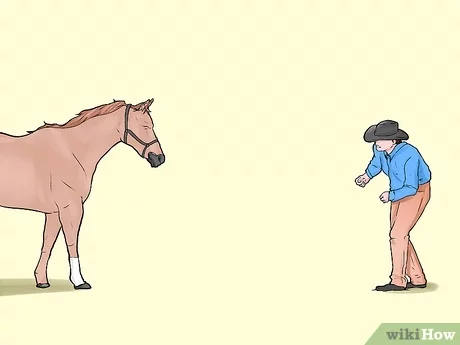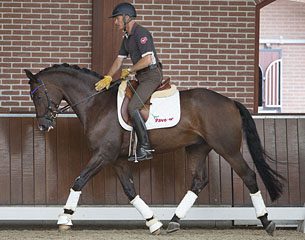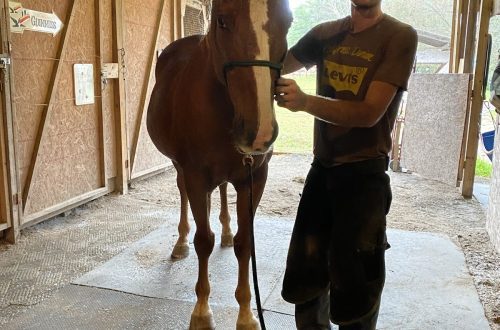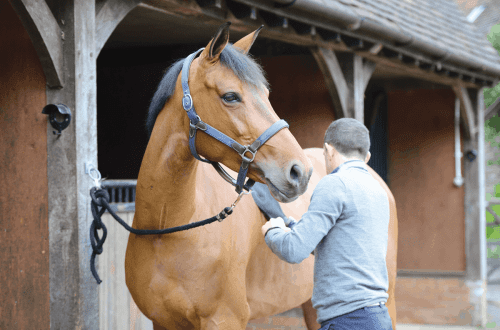
Horse, befriend me!
Horse, befriend me!
The myth of the horse
Everyone who comes to the stable for the first time has their own Myth about the Horse, their own idea of horses – these amazing, noble animals.
The myth is formed from the images that the modern world offers. Where do we usually see horses?
First of all, in films. Dashing hussars rush into battle with sabers drawn! The Indians, easily and naturally, gallop without saddles, while shooting from bows. Cowboys or knights, famously jumping over the hedges, pick up the beauties with one hand, put them behind them and save them from enemies …
In all these scenes, fearless, calm horses strictly obey the commands of the riders, and sometimes save them, showing courage and nobility.
In addition, we see horses in the paintings. Fighting heroic horses with foam at the mouth, which, standing on their hind legs, trample on enemies … Touching herds of mares with foals at a watering hole …
Someone is inspired by sports horses – spectacular, strong animals participating in breathtaking races, overcoming obstacles or gracefully “dancing” …
Often we see horses in the city. Calm and even seemingly peaceful animals. They fearlessly pass by cars under the saddle of their young riders, who either ask for money for food or offer to ride the same horses. But few people think about the price of this tranquility …
From all these images, the Myth of the Horse is formed – about a brave, tireless, faithful friend who will follow the rider into fire and into water. About a horse, on which they move mainly at a gallop, about a horse that is not afraid of anything.
Few people think about how far this myth is from the truth. People do not know how much strength and patience must be invested in an animal to become reliable, safe and obedient.
On the screen we see the fruits of editing – a horse cannot gallop a hundred kilometers, and then, without catching his breath, drink from a stream and go to rest in the stable. And so that the animal is not afraid of anything, it takes years of training and painstaking work.
A person who first came to the stable already sees himself galloping on a “war horse”. It can be difficult to come to terms with the idea that before this desired moment, you will have to devote quite a lot of time to practicing control skills and strengthening the landing. But first of all, even before getting into the saddle, it is very useful to understand how the horse perceives the world around him.
Many things open up in a new way if … you look at the world through the eyes of a horse!
Once upon a time at the circus…
The famous horse show at the arena. The premiere of the performance… About fifteen horses work in the program. For forty minutes they perform the most intricate commands, dancing, jumping, climbing a steep bridge and jumping off it. Light, music, applause… The horses know their job, nothing frightens or bothers them.
But now the performance is coming to an end, and all the participants of the show go to the arena. In honor of the premiere, circus ushers take out small bouquets of flowers from behind the curtain and give them to the artists. But what is happening? Artists can’t take flowers! Because their horses – circus, well-trained horses – shy away from small bouquets, like from fire. They were not prepared for this new, emergency situation …
So the myth of the brave war horse was dispelled. The horse is afraid of everything to which it is not accustomed. Teaching an animal not to be afraid is a huge job that requires patience and experience. A horse can become a reliable friend, but first you must earn his respect and trust.
Who is grazing in the meadow?
The horse is a herbivore, a prey animal. Man is a predator. Predators, such as lions, are naturally inclined to bask in the sun and wait for prey to run past. Catch, eat, and then lie in the sun. In other words, predators are in a calm state most of the time. In a herbivore, the psyche works in a completely different way.
For centuries, a horse’s survival has depended on how quickly it can spot an enemy and run away from him. Therefore, horses are afraid of everything that can pose a potential danger to them: dogs, cars, a bird suddenly fluttering out of the bushes, a bag lying on the road, and a million more of the most harmless things. This is fine. Fear is in the horse’s blood. An animal cannot be blindly punished just for following its natural instincts.
The way of thinking of a herbivore is alien to a person – we are higher in the food chain. But the horse has a fear of a predator from birth. She can smell the predator that comes from us. Paying attention to body language, she sees the habits of a predator. She subconsciously recognizes the enemy in us.
In some ways, raising a horse is similar to raising a dog. But dogs, cats, and even rodents are closer to us and therefore more understandable. And in order to understand a horse, one must learn to think like a horse, although this is contrary to our nature.
Let’s imagine a situation…
You are about to travel to another country. Let’s say France. Get ready, learn French. And when you walk around Paris, explaining yourself in broken French, people will try to understand you and help you. If you arrive in France, absolutely not knowing the local language and not wanting to learn it, but you demand that everyone understands you, the attitude will be completely different. There is a wonderful phrase in one film: “If a foreigner speaks to you and you do not understand him, it will not help you if he says the same thing, but louder.”
When going to the world of horses, try to learn how to speak their language! Don’t be afraid to take a step down. Yes, we are people. Perhaps we are smarter than horses. That is why WE need to learn their language. If we try to speak the “horse” language, understand the psychology of these amazing animals, understand their worldview, our interaction with them will become much more productive!
Herbivores have a lightning-fast reaction. Sometimes we just do not have time to notice what the animal took for a threat. However, there is no fear in a vacuum. The horse is a great reinsurer, and this must be taken into account. It is better to think in advance that she may be frightened of a rag lying in the grass, or a gnarled gnarled tree. Even if the horse passes calmly, you will be ready for her fright, which means you are attentive and collected. Feeling your confident attitude, the animal will overcome the “terrible” place much calmer.
In no case should you be afraid of something yourself. It is even worse to ask a horse: “Are you afraid of dogs?.. Are you afraid of cars?..” This question calls into question your authority and inspires fear. Even the calmest horse, sensing the uncertainty of the rider, will try to flee in order to protect both himself and his cowardly “cargo”. If you notice something that may alarm the animal, tell him: “I see it too, but I’m not afraid at all! Go quietly, you are under my protection! Confidently send the horse forward. Very soon, she will stop being nervous or fright will be reduced to a minimum.
There are very emotional horses that are afraid of literally everything and suspect danger at every turn. They shy away, run away or are beaten off by their hooves. You have to work with them for a long time, patiently; gradually accustom to the fact that the world is not as scary as it seems to them.
We must admit that fear is a normal reaction of the horse. Go outside and look around from the position of the victim: how many scary things can you see? Your life has never depended on how fast you can run away from a yellow plastic bag that is driven by the wind along the way!
The horse notices a lot of little things. Learn from the horse mindfulness, and in return – teach him to be brave. In fact, all this is not as difficult as it seems … Just find a confident, strong and calm personality in yourself. I am convinced that such a person exists inside everyone!
Once upon a time there was a horse
One horse was worked in a large arena, where, along the perimeter, mirrors hung on the walls (so that riders could see themselves and improve their landing). The horse was terrified of them and threw a tantrum next to each mirror. The horsemen, who knew his peculiarity, did not like to work with the horse.
But then the horse got under the saddle to the new bereytor. This rider did not know the “jump” of the horse. She did a great job, the stallion was calm and confident. When the girl brought the horse into the stall, she was asked: “How did you do it? After all, he is terribly afraid of mirrors! In response, she said: “Yes, right? Well, I didn’t know that…”
Of course, approaching an animal that weighs half a ton, a person feels a natural awkwardness. Some feel fear. This is absolutely normal and speaks of a well-developed self-preservation instinct. If it does not work when communicating with an animal, you risk injury. There is nothing wrong with being afraid of a horse. Just don’t show it to her! The horse will be confident and calm only under a confident and calm rider.
Big secret for a small company
The second most important key to the horse’s heart is the understanding that horses are herd animals.
What does it mean? First of all, you need to remember: the horse is comfortable being subordinate. There is a strict hierarchy in the herd. Each animal takes its place, its step. As a rule, the herd has a leader – the leader. This is a horse that keeps order, leads the herd to a watering place, looks out for enemies, and so on. But horses that would be comfortable playing the role of leader all the time are quite rare, especially in training rental groups.
The position of the leader, though pleasant, but obliges a lot. The leader must be in complete control of the situation 24 hours a day. Therefore, the vast majority of horses enjoy being led. They are quite comfortable when someone else thinks and makes decisions for them.
A horse becomes honest and loyal if a person can position himself as a leader in a small herd-tandem “man-horse”. If a person is confident and calm, the horse is also calm, bold and responsive in work. With a nervous and jerky behavior of a person, we get the same nervous and always alert horse.
If we are not capable of being a leader, the horse will take this position. And an animal that puts itself above a person is unpredictable and dangerous.
Unfortunately, in our time, few people have the opportunity to observe the herd in natural conditions. But even two or three horses walking together represent a herd in which there is a leader-leader. Two animals cannot occupy the same step in the herd hierarchy. Even the two oldest and weakest horses will be in different positions – one higher, the other lower.
The leader should not be aggressive, pugnacious. Horses obey him not out of fear, but out of respect. Often it is enough for the leader to simply “make a rat” (put down his ears and bare his teeth) for the rest of the horses to understand: it’s better not to touch him now. In case of disobedience of an animal lower in the hierarchy, the leader can, without entering into a fight, kick or bite – briefly and clearly. Other horses may challenge him. And in this case, the leader should remain as cold-blooded, calmly and intelligibly explaining who is in charge. Otherwise, a more persistent animal will take its position.
If a person wants to become a leader for a horse, he must behave in accordance with the rules of the herd, his movements, posture, facial expression show the horse his absolute self-confidence.
To become a leader, you need to learn how to speak with a horse in its native language – sign language.
Ksenia Krotova. Fragment of the book“Horse, rider, instructor: how to understand each other?”
Personal page of the author in VK





